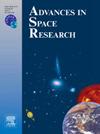高频场位波的相对论性电子散射:使用自洽产生的波场的测试粒子结果
IF 2.8
3区 地球科学
Q2 ASTRONOMY & ASTROPHYSICS
引用次数: 0
摘要
理论和模拟预测,辐射带电子与电磁离子回旋加速器(EMIC)波相互作用的共振能量通常为> 1 MeV,而实验结果表明,EMIC波也应该是亚MeV电子沉淀的原因。最近关于窄带(Δf > 0.1fcp)、高频(0.9fcp > f<fcp)电磁波(简称hfemic波)的报道表明,由于这些电磁波的波频较大(fcp表示质子回旋频率),它们有可能产生亚兆电子伏的电子散射。为了更定量地研究这一点,我们跟踪了混合模拟自一致产生的HFEMIC波场中的测试电子,并检查了由此产生的相互作用的平流和扩散行为。尽管HFEMIC波主要发生在等离子体顶外的低密度区域,但目前的研究结果表明,波数足够大,可以将共振能量降低到几百keV。对于典型振幅的HFEMIC波,所产生的俯仰角散射主要是扩散的,但当与磁层中最大振幅的波相互作用时,也会出现非线性效应。虽然准线性理论正确地预测了俯仰角扩散系数的总体水平,但边界能敏感地依赖于所使用的色散关系(从而依赖于热等离子体效应)。尽管HFEMIC波的低发生性质,但我们期望低空高能电子沉降测量可以区分其特征散射特征。本文章由计算机程序翻译,如有差异,请以英文原文为准。
Relativistic electron scattering by high-frequency EMIC waves: Test-particle results using self-consistently generated wave fields
Theory and simulations predict that the resonant energy of radiation belt electrons interacting with electromagnetic ion cyclotron (EMIC) waves is typically MeV, while experimental results suggest that EMIC waves should also be responsible for sub-MeV electron precipitation. The recent report of narrowband (), high-frequency () EMIC waves—HFEMIC waves for short—suggests the possibility of sub-MeV electron scattering by these waves owing to their large wave frequency ( denoting the proton cyclotron frequency). To investigate this more quantitatively, we trace test electrons in the HFEMIC wave fields self-consistently generated from a hybrid simulation, and examine the advective and diffusive behaviors of the resultant interactions. Even though HFEMIC waves primarily occur in low density regions outside the plasmapause, the present results show that the wavenumber is large enough to reduce the resonant energy down to as low as several 100s keV. The resulting pitch angle scattering is primarily diffusive for the typical amplitude of HFEMIC waves, but the nonlinear effects also emerge when interacting with the largest-amplitude waves found in the magnetosphere. While the quasilinear theory correctly predicts the overall level of the pitch angle diffusion coefficient, the bounding energy is sensitively dependent on the dispersion relation used (and thus on the warm plasma effect). We expect that low-altitude measurements of energetic electron precipitation can distinguish its characteristic scattering signature, despite the low occurrence nature of HFEMIC waves.
求助全文
通过发布文献求助,成功后即可免费获取论文全文。
去求助
来源期刊

Advances in Space Research
地学天文-地球科学综合
CiteScore
5.20
自引率
11.50%
发文量
800
审稿时长
5.8 months
期刊介绍:
The COSPAR publication Advances in Space Research (ASR) is an open journal covering all areas of space research including: space studies of the Earth''s surface, meteorology, climate, the Earth-Moon system, planets and small bodies of the solar system, upper atmospheres, ionospheres and magnetospheres of the Earth and planets including reference atmospheres, space plasmas in the solar system, astrophysics from space, materials sciences in space, fundamental physics in space, space debris, space weather, Earth observations of space phenomena, etc.
NB: Please note that manuscripts related to life sciences as related to space are no more accepted for submission to Advances in Space Research. Such manuscripts should now be submitted to the new COSPAR Journal Life Sciences in Space Research (LSSR).
All submissions are reviewed by two scientists in the field. COSPAR is an interdisciplinary scientific organization concerned with the progress of space research on an international scale. Operating under the rules of ICSU, COSPAR ignores political considerations and considers all questions solely from the scientific viewpoint.
 求助内容:
求助内容: 应助结果提醒方式:
应助结果提醒方式:


